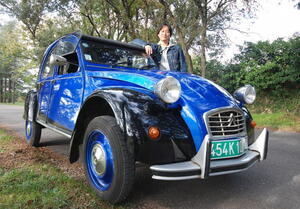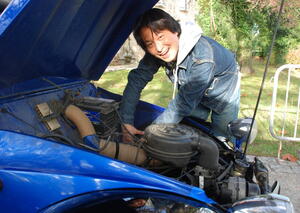The man with the shiny black and blue 2CV
Some cars are more than cars—they're an expression of personal values and aesthetics. Take the French "Deux-Chevaux" (2 CV) for instance. 2 CV means that the car falls into the fiscal category of "two horsepower" vehicles, the lowest on the French tax scale. For almost half a century, the 2 CV was a car for the thrifty: whether parish priest, student, social worker, farmer, nun or the Postal Administration. "Deux-Chevaux" were cheap to buy, cheap to fuel and cheap to maintain. The last 2CV that went off the production line in 1990 wasn't much different from the original 1949 model: it featured a slightly more powerful engine, a larger choice of colours, a four-speed clutch, and that was about it. 2CVs never really made it outside of Europe. Because of safety regulations, they were banned from the US—although one of them appears in the cult movie "American Graffiti." Quite surprisingly, however, a couple of hundred of them were exported to Japan.
And so it happened that, in 1989 in Mito, a town near Tokyo, a young Japanese student of elementary particle theory saw one them in a showroom for foreign cars. "My intention was to buy an Autobianchi Abarth," says Atsumi Terasawa, now an engineer with the ITER Tokamak Department. "But when I saw the 2CV, I instantly changed my mind. It had something 'eternal' about it, as if it had always existed..."
That day marked the beginning of a passionate relationship. Twenty years and 150,000 kilometres later, Atsumi and his 2CV are still "like one." "I have travelled everywhere with it," says Atsumi. "At one point to meet my girlfriend—who is now my wife—I would drive back and forth twice a week between Tokyo and Kyoto. That amounted to about 2,000 kilometres per week!"
To celebrate the birth of his daughter ten years ago, Atsumi decided he would design a new colour pattern for his beloved 2CV: the car was born grey and black ... it is now a unique shining blue and diamond black.
Of course, when Atsumi moved to France in order to work at ITER, the 2CV went with him —a rare and maybe unique case of a 2CV travelling back from Japan to its birthplace. "Now I drive it everyday to work. I love everything about it and I will never sell it!"
Does having a background in quantum physics make dealing with the unpredictable 2CV easier? Atsumi is not sure. But it certainly is easier, and cheaper, to maintain a 2CV in France than it was in Japan. Atsumi doesn't need to worry about the next 20 years or 150,000 kilometres: he's found "a very good repair shop" in Forcalquier, and in case his 2CV definitely breaks down (close to impossible), he left a second car in Japan—a 40-year-old Fiat Abarth.




